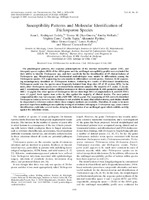Por favor, use este identificador para citar o enlazar este ítem:
http://sgc.anlis.gob.ar/handle/123456789/220| Título : | Susceptibility Patterns and Molecular Identification of Trichosporon Species | Autor : | Rodríguez-Tudela, Juan L. Diaz-Guerra, Teresa M. Mellado, Emilia Cano, Virginia Tapia, Cecilia Perkins, Alexander Gomez-Lopez, Alicia Rodero, Laura Cuenca-Estrella, Manuel |
Palabras clave : | Trichosporon;Farmacorresistencia Fúngica | Fecha de publicación : | oct-2005 | Editorial : | American Society for Microbiology | Journal: | Antimicrobial agents and chemotherapy | Resumen : | The physiological patterns, the sequence polymorphisms of the internal transcriber spacer (ITS), and intergenic spacer regions (IGS) of the rRNA genes and the antifungal susceptibility profile were evaluated for their ability to identify Trichosporon spp. and their specificity for the identification of 49 clinical isolates of Trichosporon spp. Morphological and biochemical methodologies were unable to differentiate among the Trichosporon species. ITS sequencing was also unable to differentiate several species. However, IGS1 sequencing unambiguously identified all Trichosporon isolates. Following the results of DNA-based identification, Trichosporon asahii was the species most frequently isolated from deep sites (15 of 25 strains; 60%). In the main, other Trichosporon species were recovered from cutaneous samples. The majority of T. asahii, T. faecale, and T. coremiiforme clinical isolates exhibited resistance in vitro to amphotericin B, with geometric mean (GM) MICs >4 mug/ml. The other species of Trichosporon did not show high MICs of amphotericin B, and GM MICs were <1 mug/ml. Azole agents were active in vitro against the majority of clinical strains. The most potent compound in vitro was voriconazole, with a GM MIC |
Descripción : | Fil: Rodriguez-Tudela, Juan L. Instituto de Salud Carlos III. Servicio de Micología; España. Fil: Diaz-Guerra, Teresa M. Instituto de Salud Carlos III. Servicio de Micología; España. Fil: Mellado, Emilia. Instituto de Salud Carlos III. Servicio de Micología; España. Fil: Cano, Virginia. ANLIS Dr.C.G.Malbrán. Instituto Nacional de Enfermedades Infecciosas. Departamento de Micología; Argentina. Fil: Tapia, Cecilia. Universidad de Chile. Programa de Microbiología y Micología; Chile. Fil: Perkins, Alexander. Instituto de Salud Carlos III. Servicio de Micología; España. Fil: Gomez-Lopez, Alicia. Instituto de Salud Carlos III. Servicio de Micología; España. Fil: Rodero, Laura. ANLIS Dr.C.G.Malbrán. Instituto Nacional de Enfermedades Infecciosas. Departamento de Micología; Argentina. Fil: Cuenca-Estrella, Manuel. Instituto de Salud Carlos III. Servicio de Micología; España. |
URI : | http://sgc.anlis.gob.ar/handle/123456789/220 http://aac.asm.org/content/49/10/4026.full.pdf+html |
ISSN : | 1098-6596 | DOI: | 10.1128-AAC.49.10.4026-4034.2005 Free PMC article | Derechos: | info:eu-repo/semantics/openAccess Open Access Creative Commons Attribution 4.0 International License |
| Aparece en las colecciones: | snrd Publicaciones INEI |
Ficheros en este ítem:
| Fichero | Descripción | Tamaño | Formato | |
|---|---|---|---|---|
| AntimicrobialAgentsandChemotherapy,2005,49(10),4026–4034..pdf | Artículo de inglés | 128.98 kB | Adobe PDF |  Visualizar/Abrir |
Visualizaciones de página(s)
163
comprobado en 15-dic-2025
Descarga(s)
73
comprobado en 15-dic-2025
Google ScholarTM
Consultar
Altmetric
Altmetric
Este ítem está sujeto a una licencia Creative Commons Licencia Creative Commons


